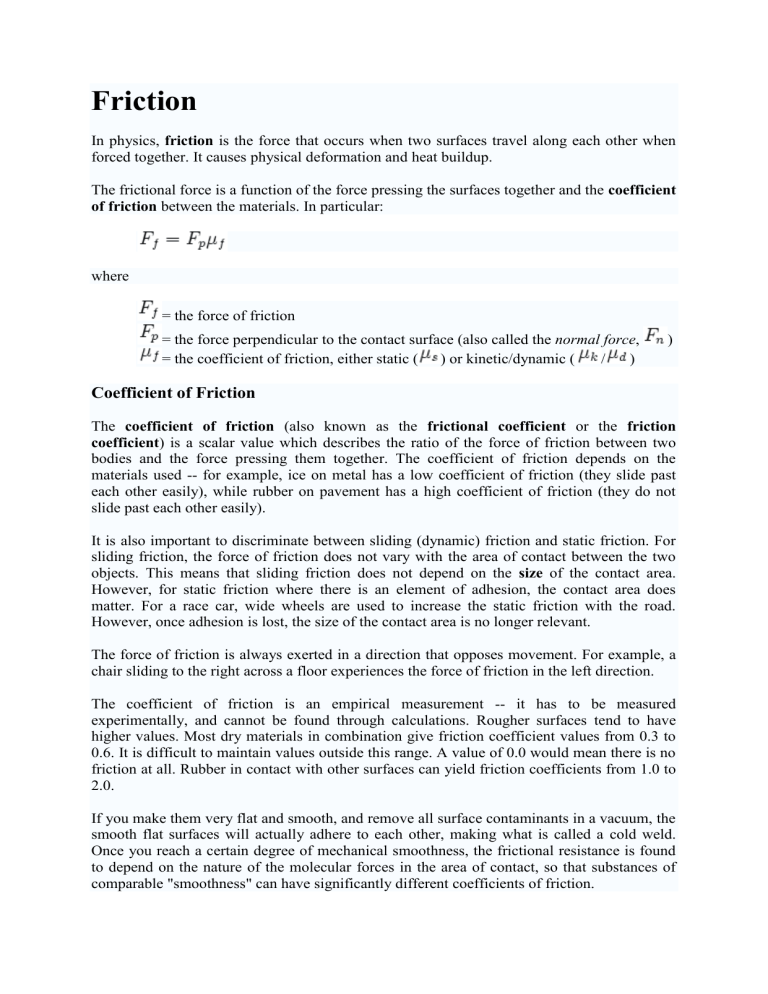Coefficient of Friction

Friction
In physics, friction is the force that occurs when two surfaces travel along each other when forced together. It causes physical deformation and heat buildup.
The frictional force is a function of the force pressing the surfaces together and the coefficient of friction between the materials. In particular: where
= the force of friction
= the force perpendicular to the contact surface (also called the normal force , )
= the coefficient of friction, either static ( ) or kinetic/dynamic ( / )
Coefficient of Friction
The coefficient of friction (also known as the frictional coefficient or the friction coefficient ) is a scalar value which describes the ratio of the force of friction between two bodies and the force pressing them together. The coefficient of friction depends on the materials used -- for example, ice on metal has a low coefficient of friction (they slide past each other easily), while rubber on pavement has a high coefficient of friction (they do not slide past each other easily).
It is also important to discriminate between sliding (dynamic) friction and static friction. For sliding friction, the force of friction does not vary with the area of contact between the two objects. This means that sliding friction does not depend on the size of the contact area.
However, for static friction where there is an element of adhesion, the contact area does matter. For a race car, wide wheels are used to increase the static friction with the road.
However, once adhesion is lost, the size of the contact area is no longer relevant.
The force of friction is always exerted in a direction that opposes movement. For example, a chair sliding to the right across a floor experiences the force of friction in the left direction.
The coefficient of friction is an empirical measurement -- it has to be measured experimentally, and cannot be found through calculations. Rougher surfaces tend to have higher values. Most dry materials in combination give friction coefficient values from 0.3 to
0.6. It is difficult to maintain values outside this range. A value of 0.0 would mean there is no friction at all. Rubber in contact with other surfaces can yield friction coefficients from 1.0 to
2.0.
If you make them very flat and smooth, and remove all surface contaminants in a vacuum, the smooth flat surfaces will actually adhere to each other, making what is called a cold weld.
Once you reach a certain degree of mechanical smoothness, the frictional resistance is found to depend on the nature of the molecular forces in the area of contact, so that substances of comparable "smoothness" can have significantly different coefficients of friction.
Types of Friction
Static Friction
Static friction occurs when the two objects are not moving relative to each other (like a desk on the ground). The coefficient of static friction is typically denoted as μ s
. The initial force to get an object moving is often dominated by static friction.
Rolling friction occurs moving relative to each other and one "rolls" on the other (like a car's wheels on the ground). This is classified under static friction because the patch of the tire in contact with the ground, at any point while the tire spins, is stationary relative to the ground. The coefficient of rolling friction is typically denoted as
μ r
.
Kinetic Friction
Kinetic friction occurs when two objects are moving relative to each other and rub together
(like a sled on the ground). The coefficient of kinetic friction is typically denoted as μ k
, and is usually less than the coefficient of static friction.
The work done by friction can translate into deformation and heat that in the long run may affect the surface's specification and the coefficient of friction itself. Friction can in some cases cause solid materials to melt.
Reducing Friction
Devices
Devices, such as ball bearings, can change sliding friction into the less significant rolling friction.
Lubricants
A common way to reduce friction is by using a lubricant, such as oil, that is placed between the two surfaces, often dramatically lessening the coefficient of friction.
Products of friction
According to the law of conservation of energy, no energy should be lost due to friction. The kinetic energy lost is transformed primarily into heat and/or motion of other objects and fluids. An airplane will heat and accelerate the air as it passes. A submarine will do the same to the water. In some cases, the "other object" to be accelerated may be the Earth. A sliding hockey puck will come to rest due to friction both by changing its energy into heat and accelerating the Earth in its direction of travel (by an immeasurable amount). Since heat and fluid motion quickly dissipate and the change in velocity of the Earth can't be seen, many early philosophers, such as Aristotle, concluded that moving objects lose energy without an opposing force





